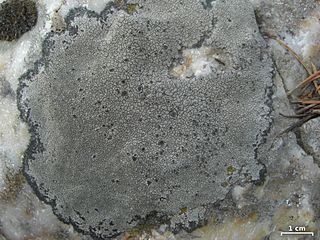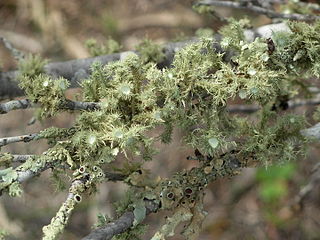
Caenorhabditis elegans is a free-living transparent nematode about 1 mm in length that lives in temperate soil environments. It is the type species of its genus. The name is a blend of the Greek caeno- (recent), rhabditis (rod-like) and Latin elegans (elegant). In 1900, Maupas initially named it Rhabditides elegans. Osche placed it in the subgenus Caenorhabditis in 1952, and in 1955, Dougherty raised Caenorhabditis to the status of genus.

A lichen is a composite organism that arises from algae or cyanobacteria living among filaments of multiple fungi species in a mutualistic relationship. Lichens have properties different from those of their component organisms. They come in many colors, sizes, and forms and are sometimes plant-like, but are not plants. They may have tiny, leafless branches (fruticose); flat leaf-like structures (foliose); grow crust-like, adhering tightly to a surface (substrate) like a thick coat of paint (crustose); have a powder-like appearance (leprose); or other growth forms.

Lichen planus (LP) is a chronic inflammatory and immune-mediated disease that affects the skin, nails, hair, and mucous membranes. It is not an actual lichen, and is only named that because it looks like one. It is characterized by polygonal, flat-topped, violaceous papules and plaques with overlying, reticulated, fine white scale, commonly affecting dorsal hands, flexural wrists and forearms, trunk, anterior lower legs and oral mucosa. The hue may be gray-brown in people with darker skin. Although there is a broad clinical range of LP manifestations, the skin and oral cavity remain as the major sites of involvement. The cause is unknown, but it is thought to be the result of an autoimmune process with an unknown initial trigger. There is no cure, but many different medications and procedures have been used in efforts to control the symptoms.

Parietin is the predominant cortical pigment of lichens in the genus Caloplaca, a secondary product of the lichen Xanthoria parietina, and a pigment found in the roots of Curled Dock. It has an orangy-yellow color and absorbs blue light.

The Verrucariaceae are a family of mostly lichenised fungi in the order Verrucariales. The lichen-forming species, which comprise the vast majority of the family, have a wide variety of thallus forms, and include crustose (crust-like), foliose (bushy), and squamulose (scaly) representatives. Several characteristics of the spore-bearing structures, the ascomata, define the family, including their perithecioid form–more or less spherical or flask-shaped, with a single opening and otherwise completely enclosed by a wall. Squamulose members of the Verrucariaceae with simple ascospores, and without algae in the spore-bearing region are known as catapyrenioid lichens; there are more than 80 of these species. The family has several dozen lichenicolous (lichen-dwelling) examples, and a few genera that contain solely lichenicolous members. An unusually diverse variety of photobiont partners have been recorded, mostly green algae, but also brown algae and yellow-green algae.

Xanthoria elegans, commonly known as the elegant sunburst lichen, is a lichenized species of fungus in the genus Xanthoria, family Teloschistaceae. Recognized by its bright orange or red pigmentation, this species grows on rocks, often near bird or rodent perches. It has a circumpolar and alpine distribution. It was one of the first lichens to be used for the rock-face dating method known as lichenometry.

Xanthoria is a genus of lichenized fungi in the family Teloschistaceae. Common names include orange lichen, orange wall lichen, and sunburst lichen. They can be identified by their characteristic squamulose morphology with distinctive "fairy cups".
Sclerophyton is a genus of lichen-forming fungi in the family Opegraphaceae. It has about 15 species. The genus was circumscribed by German lichenologist Franz Gerhard Eschweiler in 1824, with Sclerophyton elegans assigned as the type species.

Bellemerea is a genus of saxicolous (rock-dwelling) crustose lichens in the family Lecideaceae. The genus was circumscribed in 1984 by Josef Hafellner and Claude Roux, with B. alpina as the type species. The generic name honours French lichenologist André Henri Bellemère (1927–2014).
Arthonia elegans is a species of lichen in the family Arthoniaceae.
Myriospora elegans is a species of lichenized fungi in the family Acarosporaceae.
Coccocarpia elegans is a species of lichenized fungi in the family Coccocarpiaceae. A specimen kept at Geneva city herbarium was collected in 1881 in Apiahy, Brazil.

Hapters are short, peg-like attachments of the lower surface of lichen to the substrate on which they grow. They are distinct from rhizines, which are more hair-like.

Usnea scabrida is a foliose lichen that grows from holdfasts on trees. It occurs in southwest Western Australia. It is a very pale grayish-yellowish green, slender, pendant, branching from the base, unequally branching, and shrubby. The cortex contains usnic acid, and the medulla contains scabrosins. The lichen was described as a new species in 1844 by English botanist Thomas Taylor.
James Stirton was a Scottish physician and one of Scotland's leading experts on cryptogamic botany. His investigations in bryology and lichenology earned him a world-wide reputation.
Bellemerea elegans is a species of saxicolous (rock-dwelling) and crustose lichen in the family Lecideaceae. Found in Antarctica, it was formally described as a new species in 2009 by Norwegian lichenologist Dag Øvstedal. The type specimen was collected from the Admiralty Bay area of King George Island. Here, at an altitude of 105 m (344 ft), it was found growing on boulders that were overgrown with the beard lichen Usnea aurantiacoatra. Bellemerea elegans is only known from the type specimen. It has a crustose, grey, areolate thallus measuring 1–2 cm (0.4–0.8 in) wide. Its apothecia are more or less immersed in the thallus (aspicilioid), measuring up to 1.1 in diameter, with a dull brown disc. Ascospores number eight per ascus, and measure 12–14 by 5–7 μm. The lichen contains porphyrilic acid, a lichen product.

The following outline provides an overview of and topical guide to lichens.










